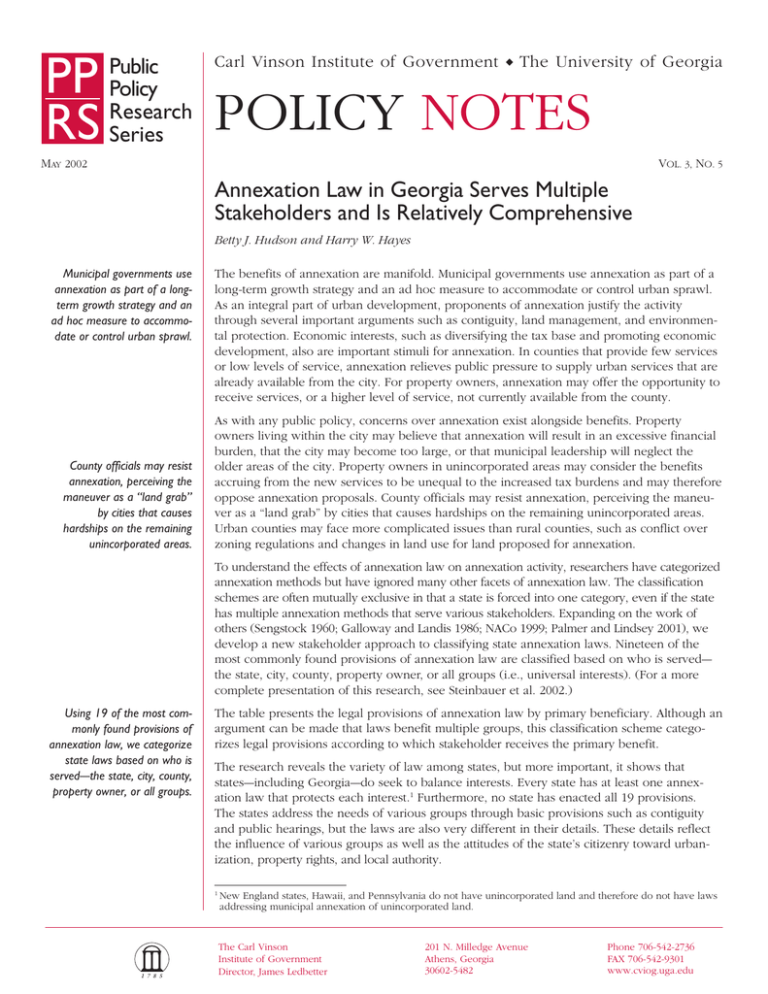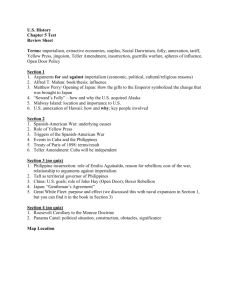Annexation Law in Georgia Serves Multiple Stakeholders and Is Relatively Comprehensive
advertisement

PP RS Public Policy Research Series Carl Vinson Institute of Government ◆ The University of Georgia POLICY NOTES MAY 2002 VOL. 3, NO. 5 Annexation Law in Georgia Serves Multiple Stakeholders and Is Relatively Comprehensive Betty J. Hudson and Harry W. Hayes Municipal governments use annexation as part of a longterm growth strategy and an ad hoc measure to accommodate or control urban sprawl. County officials may resist annexation, perceiving the maneuver as a “land grab” by cities that causes hardships on the remaining unincorporated areas. The benefits of annexation are manifold. Municipal governments use annexation as part of a long-term growth strategy and an ad hoc measure to accommodate or control urban sprawl. As an integral part of urban development, proponents of annexation justify the activity through several important arguments such as contiguity, land management, and environmental protection. Economic interests, such as diversifying the tax base and promoting economic development, also are important stimuli for annexation. In counties that provide few services or low levels of service, annexation relieves public pressure to supply urban services that are already available from the city. For property owners, annexation may offer the opportunity to receive services, or a higher level of service, not currently available from the county. As with any public policy, concerns over annexation exist alongside benefits. Property owners living within the city may believe that annexation will result in an excessive financial burden, that the city may become too large, or that municipal leadership will neglect the older areas of the city. Property owners in unincorporated areas may consider the benefits accruing from the new services to be unequal to the increased tax burdens and may therefore oppose annexation proposals. County officials may resist annexation, perceiving the maneuver as a “land grab” by cities that causes hardships on the remaining unincorporated areas. Urban counties may face more complicated issues than rural counties, such as conflict over zoning regulations and changes in land use for land proposed for annexation. To understand the effects of annexation law on annexation activity, researchers have categorized annexation methods but have ignored many other facets of annexation law. The classification schemes are often mutually exclusive in that a state is forced into one category, even if the state has multiple annexation methods that serve various stakeholders. Expanding on the work of others (Sengstock 1960; Galloway and Landis 1986; NACo 1999; Palmer and Lindsey 2001), we develop a new stakeholder approach to classifying state annexation laws. Nineteen of the most commonly found provisions of annexation law are classified based on who is served— the state, city, county, property owner, or all groups (i.e., universal interests). (For a more complete presentation of this research, see Steinbauer et al. 2002.) Using 19 of the most commonly found provisions of annexation law, we categorize state laws based on who is served—the state, city, county, property owner, or all groups. The table presents the legal provisions of annexation law by primary beneficiary. Although an argument can be made that laws benefit multiple groups, this classification scheme categorizes legal provisions according to which stakeholder receives the primary benefit. The research reveals the variety of law among states, but more important, it shows that states—including Georgia—do seek to balance interests. Every state has at least one annexation law that protects each interest.1 Furthermore, no state has enacted all 19 provisions. The states address the needs of various groups through basic provisions such as contiguity and public hearings, but the laws are also very different in their details. These details reflect the influence of various groups as well as the attitudes of the state’s citizenry toward urbanization, property rights, and local authority. 1 1 7 8 5 New England states, Hawaii, and Pennsylvania do not have unincorporated land and therefore do not have laws addressing municipal annexation of unincorporated land. The Carl Vinson Institute of Government Director, James Ledbetter 201 N. Milledge Avenue Athens, Georgia 30602-5482 Phone 706-542-2736 FAX 706-542-9301 www.cviog.uga.edu The requirement for contiguity is the most widely utilized annexation law in the nation, adopted by all but one of the states that permit municipal annexation of unincorporated areas. Other widely enacted legal provisions include annexation by local ordinance (93 percent), annexation upon the petition of either the property owner or the voters of an area (93 percent), and the requirement for some type of public hearing (88 percent). Georgia law generally requires that an area to be annexed be contiguous to the annexing city, with very limited exceptions. The state’s municipalities are authorized to annex by local ordinance and by property owners or a combination of property owners and residents petitioning the city. A public hearing is required under one of the annexation methods. At the other end of the spectrum of state regulation, only 17 percent of states require the preparation of impact reports prior to annexation or facilitate annexation for reasons of health or safety hazards. Twenty-nine percent of states have some type of boundary agency with authority over annexations. Georgia is among the majority of states that have not adopted any of these provisions. Georgia has enacted 13 of the 19 most common annexation legal provisions— more than any other state. Provisions of Annexation Law, by Primary Beneficiary or Stakeholder State Property Owner/ Resident of Area Universal Benefit County Municipality Boundary Agencies (29 percent) Contiguity Required (98 percent) GA Noncontiguity Allowed (33 percent) Service Plans (48 percent) GA Abate Health and Safety Hazards (17 percent) Annex by Legislature (14 percent) GA Impact Plans (17 percent) Municipal Land: Ease Annexation (52 percent) GA Election in Area to be Annexedc (67 percent) GA Public Hearing (88 percent) GA Judial Review: Judicial Decisiona Islands: Forbid Creationb GA Islands: Ease in Annexationb GA Annex through Petition (93 percent) GA Judical Review: Appeal Annexationa GA County Approval (48 percent) GA Cross-county Annexation (40 percent) GA c Election in City Historically, annexation in Georgia (40 percent) has been and continues to be a Annex through Local Ordinance controversial topic, as evidenced (93 percent) GA by the recent Association County Notes: The 19 legal provisions included in this table are based on a review of 1999 annexation laws in all 50 states. The perCommissioners of Georgia and the centages of states that have a provision are in parentheses. GA = the provision has been enacted in Georgia. a Provisions related to judicial review include judicial decision-making authority on proposed annexations and/or the right of Georgia Municipal Association an affected party to appeal an annexation. Eighty-five percent of states have at least one law pertaining to judicial review. Joint Task Force on Annexation. b Provisions pertaining to unincorporated islands include those that facilitate annexation of existing islands and/or those that As our analysis indicates, however, prohibit the creation of new islands. Fifty-five percent of states have at least one law pertaining to unincorporated islands. c Provisions related to elections include the holding of elections in the area to be annexed or elections in that area and in the Georgia annexation law is relaexisting city. tively comprehensive: Georgia has enacted 13 of the 19 most common annexation legal provisions—more than any other state. Moreover, although the state’s provisions have developed incrementally, they clearly reflect the major interests of essential stakeholders. Select Sources Galloway, Thomas D., and John D. Landis. 1986. How cities expand: Does state law make a difference? Growth and Change 17, no. 4: 25–45. National Association of Counties (NACo). 1999. Annexation: A state by state guide. Washington, D.C.: NACo. Palmer, Jamie L., and Greg Lindsey. 2001. Classifying state approaches to annexation. State and Local Government Review 33, no. 1: 60–73. Sengstock, Frank D. 1960. Annexation: A solution to the metropolitan problem. Ann Arbor: University of Michigan Law School. Steinbauer, Paula E., Betty J. Hudson, Harry W. Hayes, and Rex L. Facer III. 2002. An Assessment of Municipal Annexation in Georgia and the United States: A Search for Policy Guidance. Athens: Carl Vinson Institute of Government, University of Georgia. Contacts for More Information Authors (706-542-2736) Betty J. Hudson and Harry W. Hayes Governmental Services Division Carl Vinson Institute of Government University of Georgia hudson@cviog.uga.edu hayes@cviog.uga.edu Series Editor (706-542-2736) Richard W. Campbell Carl Vinson Institute of Government University of Georgia campbell@cviog.uga.edu






